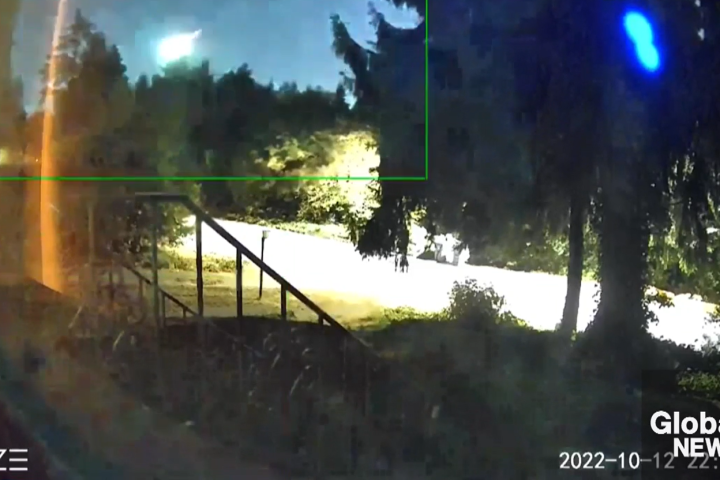
It may have only lasted a few seconds, but it lit up the night sky and dazzled residents of Vancouver Island’s South Coast.
A meteor was spotted just after 10:15 p.m. on Wednesday, captured on doorbell and security cameras hurtling into Earth’s atmosphere at around 66 kilometres per second.
“Never seen anything like it,” said witness Susan Reno.
Read more: Bright fireball streaks across Edmonton sky Monday night
Read More
According to astronomer David Balam, principal investigator for Space Guard Canada, the meteor was likely trail debris from Halley’s Comet, last seen in 1986 and 1910.
The annual Orionid Meteor Shower, when Earth passes through the inbound debris of Halley’s Comet, began on Oct. 2 and is expected to last until Nov. 7.
“Every year we come around in our orbit and we run through the debris trail and have spectacular displays of meteors,” Balam explained. “This is a meteor-rich time of year.”

0:31 Fireball streaks across Edmonton sky Monday night
As of Thursday morning, the American Meteor Society had received 143 witness reports of the fireball from as far north as Cumberland, B.C., as far east as Creston, B.C. and as far south as Rosenburg, Ore.
Balam estimated the meteor to be a few centimetres in diameter, and that it burned up about 64 kilometres from the surface.
“It looks to me like it came in from the northwest, across the Olympic Peninsula,” he told Global News. “If it left any stones at all, it was probably somewhere over the forest of the Olympic Peninsula and toward Seattle.”
Read more: Meteorite fragments likely near east shore of Lake Simcoe after shooting star seen Sunday
Based on its brightness, however, HR MacMillan Space Centre astronomer Marley Leacock estimated its size to be about a metre in diameter.
While the two experts’ size estimates varied significantly, both were far smaller than the football stadium-sized object astronomers say would be able to devastate life on Earth if it struck.
“As it burned up through the atmosphere it got really bright because of the size that it was,” Leacock explained. “It was a pretty bright flash of light.”
An exceptionally bright meteor is known as a bolide. Given its makeup of ice and rock, however, Leacock, said the chances of retrieving anything off the ground from the meteor are “pretty slim.”

1:44 NASA confirms DART mission succeeded in altering targeted asteroid’s trajectory
Meteor showers offer opportunities to learn more about planetary defence, she added, as scientists can study how the objects break apart and enter the atmosphere.
Last month, NASA’s DART spacecraft successfully smashed into, and deflected, a harmless asteroid as a test of planetary defence. The project cost about US$330 million, or $454 million in Canada.
© 2022 Global News, a division of Corus Entertainment Inc.



